Understanding Different Countries 🔗
Imagine this scenario: Sayid’s boss has asked him to manage a large, global team. In this new role, he’ll be working closely with people in several different countries. He’s excited about the opportunities that this connectedness will present, but he’s also nervous about making cross-cultural faux pas.
He knows that cultural differences can act as a barrier to communication, and that they could affect his ability to build connections and motivate people. So, how can he begin to understand these differences and work effectively with people from different cultures?

Learn how to work with teams and co-workers from around the world.
In this article, we’ll explore how you can use Hofstede’s Six Dimensions of Culture to work effectively with people from a range of cultural and geographic backgrounds.
What Are Hofstede’s Six Dimensions of Culture? 🔗
Identifying, quantifying, and understanding these invisible cultural forces constitutes the lifework of Dutch social psychologist Geert Hofstede. Fascinated by the consequences of cultural differences for international communication and management, Hofstede developed a six-dimensional framework for discerning the phenomenon of cultural difference. Dr. Geert Hofstede published his cultural dimensions model at the end of the 1970s, based on a decade of research. Since then, it’s become an internationally recognized standard for understanding cultural differences.
Hofstede studied people who worked for IBM in more than 50 countries. Initially, he identified four dimensions that could distinguish one culture from another. Later, he added fifth and sixth dimensions, in cooperation with Drs Michael H. Bond and Michael Minkov. These are:
- Power Distance Index (high versus low).
- Individualism versus Collectivism.
- Masculinity versus Femininity.
- Uncertainty Avoidance Index (high versus low).
- Long- versus Short-Term Orientation.
- Indulgence versus Restraint.
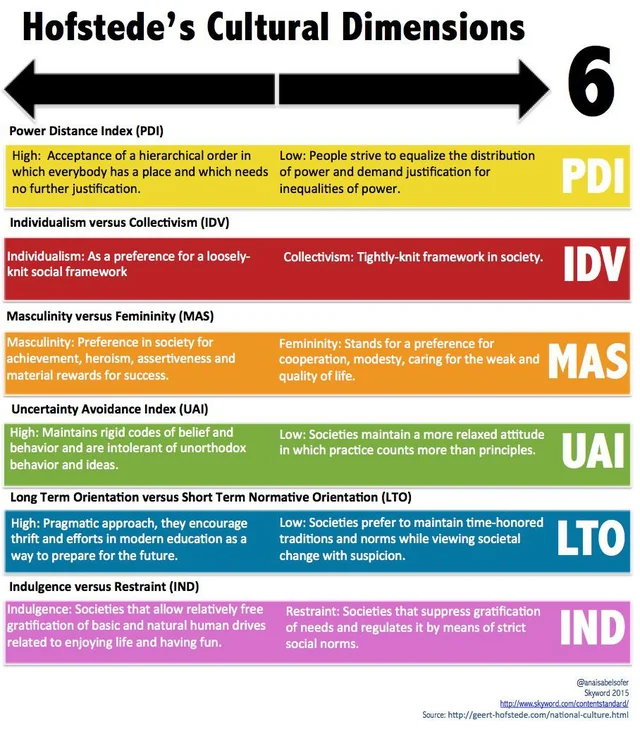
Hofstede, Bond and Minkov scored each country on a scale of 0 to 100 for each dimension.
When Hofstede analyzed his database of culture statistics, he found clear patterns of similarity and difference along the four dimensions. And, because his research focused solely on IBM employees, he could attribute those patterns to national differences, and minimize the impact of company culture.
Let’s look at the six dimensions in more detail.
Measuring Difference 🔗
Today, Hofstede’s methodology and the six dimensions of cultural values that he identified continue to be a hallmark for research in academic disciplines ranging from communication to anthropology. His framework finds numerous practical applications in fields like international business negotiations, global marketing, software companies, and non-profit management.
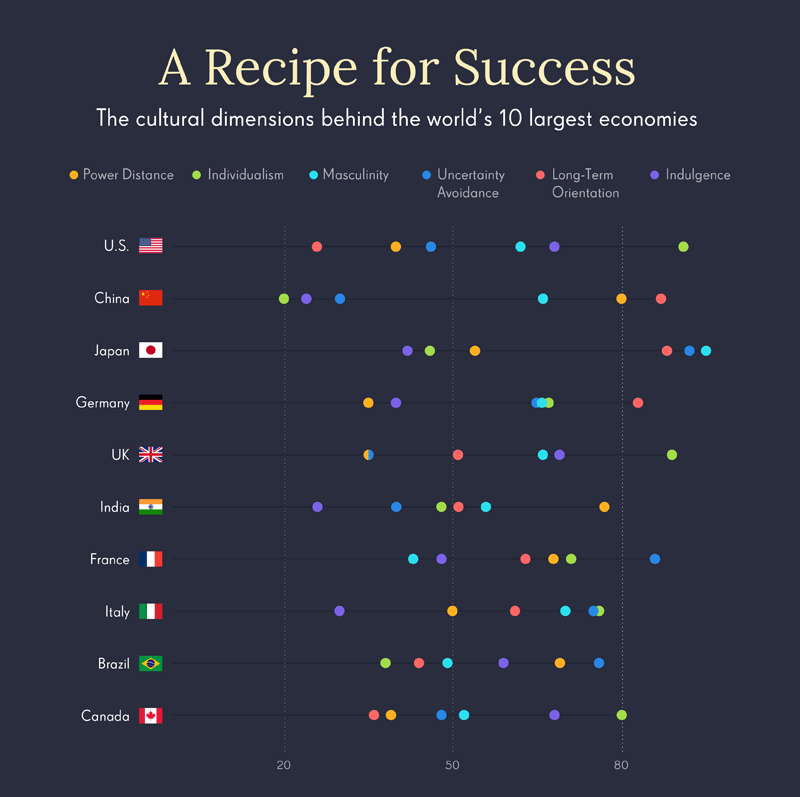
Power Distance Index (PDI) 🔗
This refers to the degree of inequality that exists – and is accepted – between people with and without power.
Countries with high PDI scores are generally those with stark hierarchies, where the less powerful are taught to “know their place” and respect authority. High PDI scores correlate with deferential relationships between students and teachers, children and parents, wives and husbands, employees and employers, subjects and rulers.
Low PDI scores, on the other hand, do not mean that social and financial capital is completely and evenly distributed. A low PDI score means that power is shared and is widely dispersed, and that society members do not accept situations where power is distributed unequally. They instead correlate with a lack of observance of differences in rank and status. People from countries with low PDI scores are less likely to drastically change their manner of speaking depending on the status of the person they are addressing.
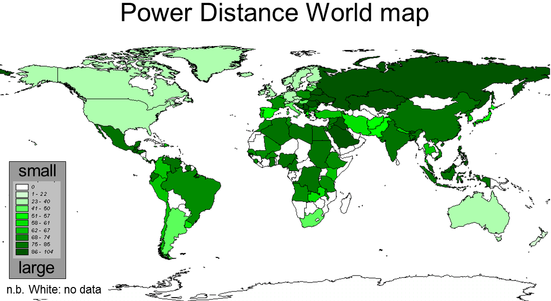
Application: According to the model, in a high PDI country, such as Malaysia 🇲🇾 (100), team members will not initiate any action, and they like to be guided and directed to complete a task. If a manager doesn’t take charge, they may think that the task isn’t important.
| PDI | Characteristics | Tips for this characteristic |
|---|---|---|
| High PDI | ⚪ Centralized organizations. ⚪ More complex hierarchies. ⚪ Large gaps in compensation, authority and respect. |
» Acknowledge a leader’s status. As an outsider, you may try to circumvent his or her power, but don’t push back explicitly. » Be aware that you may need to go to the top for answers. |
| Low PDI | ⚪ Flatter organizations. ⚪ Supervisors and employees are considered almost as equals. |
» Delegate as much as possible. » Ideally, involve all those in decision making who will be directly affected by the decision. |
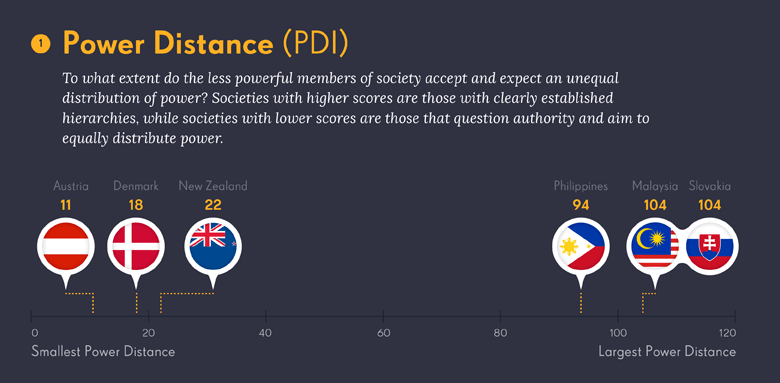
Given the endless diversity of world cultures, scientifically quantifying cultural difference may seem like a moot cause muddled by far too many uncontrolled variables. Dr. Hofstede, however, identified six issues where distinct preferences for one state of affairs over another were traceable along national lines.
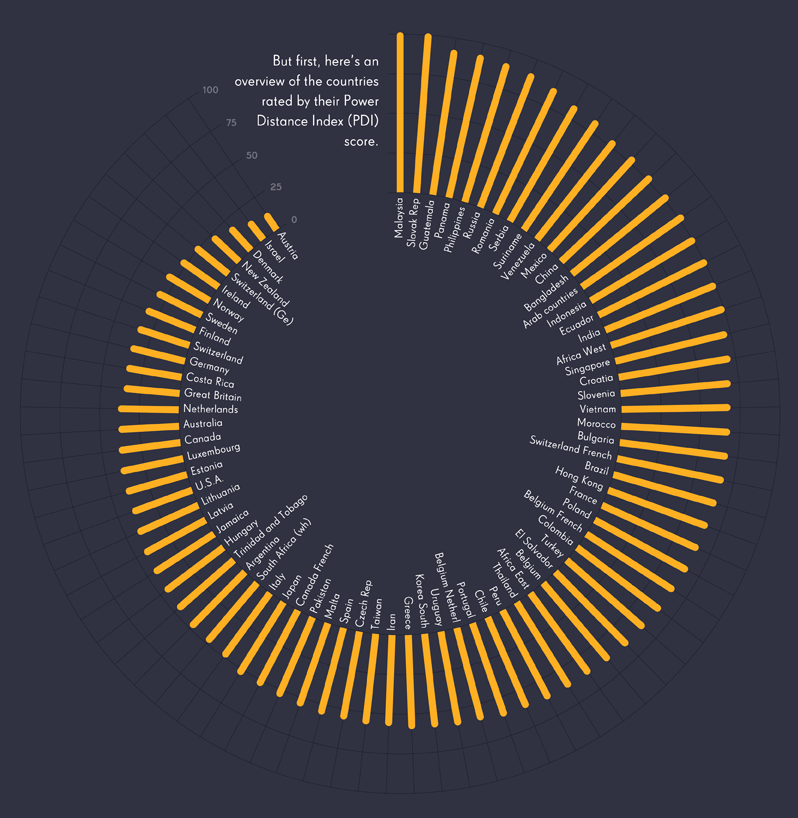
Individualism Versus Collectivism (IDV) 🔗
This refers to the strength of the ties that people have to others within their community.
A high IDV score indicates weak interpersonal connection among those who are not part of a core “family.” Here, people take less responsibility for others’ actions and outcomes. In countries with high IDV scores, people generally show a preference for smaller, more loosely-knit social frameworks and are reluctant to extend their conception of their own personal responsibility beyond the bounds of immediate family. In highly individualistic societies, people act primarily in service of their own interests, opinions, and well-being. They may glean very little satisfaction from the accomplishments of others as opposed to their own individual accomplishments.
In a collectivist society, however, people are supposed to be loyal to the group to which they belong, and, in exchange, the group will defend their interests. The group itself is normally larger, and people take responsibility for one another’s well-being. Countries with low IDV scores can be described as collectivistic. Members of these societies are more likely to feel loyalty to and personal responsibility for the well-being of their community at large. In highly collectivistic societies, people act primarily in service of a wider group dynamic and are willing to suppress their own opinions or interests in order to preserve harmony. They feel a sense of pride in the accomplishments of others from within their community, and see their own accomplishments as reflecting back on their community.
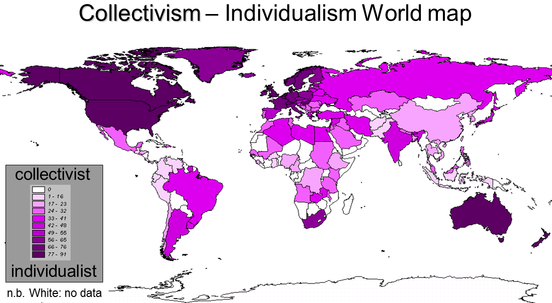
Application: Central American countries like Panama 🇵🇦 and Guatemala 🇬🇹 have very low IDV scores (11 and six, respectively). In these countries, as an example, a marketing campaign that emphasizes benefits to the community would likely be understood and well received, as long as the people addressed feel part of the same group.
| IDV | Characteristics | Tips for this characteristic |
|---|---|---|
| High IDV | ⚪ High value placed on people’s time and their need for privacy and freedom. ⚪ An enjoyment of challenges, and an expectation of individual rewards for hard work. ⚪ Respect for privacy. |
» Acknowledge individual accomplishments. » Don’t mix work life with social life too much. » Encourage debate and expression of people’s own ideas. |
| High IDV | ⚪ Emphasis on building skills and becoming master of something. ⚪ People work for intrinsic rewards. ⚪ Maintaining harmony among group members overrides other moral issues. |
» Wisdom is important. » Suppress feelings and emotions that may endanger harmony. » Avoid giving negative feedback in public. » Saying “No” can cause loss of face, unless it’s intended to be polite. For example, declining an invitation several times is expected. |
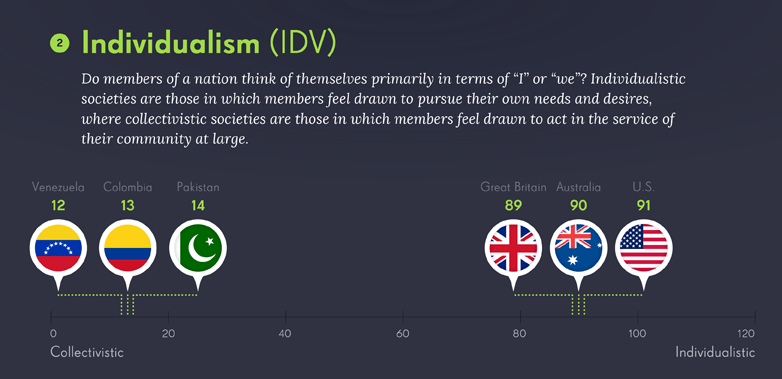
Masculinity Versus Femininity (MAS) 🔗
This refers to the distribution of roles between men and women. In masculine societies, the roles of men and women overlap less, and men are expected to behave assertively. Demonstrating your success, and being strong and fast, are seen as positive characteristics.
Countries with high MAS scores are those in which the domineering, the high-achieving, and the heroic are rewarded with material riches and public recognition. Regardless of their gender, people in these countries are taught from a young age that life consists of a never-ending series of competitions and that the journey to the top is cut-throat.
In feminine societies, however, there is a great deal of overlap between male and female roles, and modesty is perceived as a virtue. Greater importance is placed on good relationships with your direct supervisors, or working with people who cooperate well with one another.
Countries with low MAS scores can be described as valuing traditionally feminine traits, such as modesty, empathy, and agreeableness, over more masculine ones. Within these societies, public discourse is defined by collaboration, consensus, and a concern for improving the quality of life for all. The idea of caring for the weak is more likely to resonate with and motivate members of feminine societies than would the idea of defeating opponents.
The gap between men’s and women’s values is largest in Japan and Austria, with MAS scores of 95 and 79 respectively. In both countries, men score highly for exhibiting “tough,” masculine values and behaviors, but, in fact, women also score relatively highly for having masculine values, though on average lower than men.
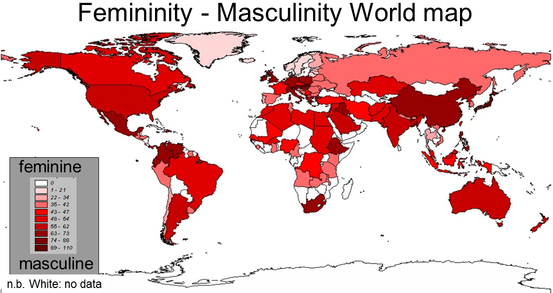
Application: As we’ve highlighted, Japan has the highest MAS score of 95, whereas Sweden has the lowest measured value of five. Therefore, if you open an office in Japan, you should recognize you are operating in a hierarchical, deferential and traditionally patriarchal society. Long hours are the norm. And this can make it harder for female team members to gain advancement, due to family commitments.
At the same time, Japan is a culture where all children (male and female) learn the value of competition and winning as part of a team from a young age. Therefore, female team members are just as likely to display these notionally masculine traits as their male colleagues.
By comparison, Sweden is a very feminine society, according to Hofstede’s model. Here, people focus on managing through discussion, consensus, compromise, and negotiation.
| MAS | Characteristics | Tips for this characteristic |
|---|---|---|
| High MAS | ⚪ Strong egos – feelings of pride and importance are attributed to status. ⚪ Money and achievement are important. |
» Be aware of the possibility of differentiated gender roles. » A long-hours culture may be the norm, so recognize its opportunities and risks. » People are motivated by precise targets, and by being able to show that they achieved them either as a group or as individuals. |
| Low MAS | ⚪ Relationship oriented/consensual. ⚪ More focus on quality of life. |
» Success is more likely to be achieved through negotiation, collaboration and input from all levels. » Avoid an “old boys’ club” mentality, although this may still exist. » Workplace flexibility and work-life balance may be important, both in terms of job design, organizational environment and culture, and the way that performance management can be best realized. |

Uncertainty Avoidance Index (UAI) 🔗
This dimension describes how well people can cope with anxiety.
In societies that score highly for Uncertainty Avoidance, people attempt to make life as predictable and controllable as possible. If they find that they can’t control their own lives, they may be tempted to stop trying. These people may refer to “mañana,” or put their fate “in the hands of God.”
People generally place a great deal of importance on long-held social conventions. They see adherence to these conventions as an indicator of overall safety and prosperity. When challenges to these structures arise, members of high UAI countries may be inclined to respond with either aggressive controls or despair. Within these countries, unorthodoxy is generally regarded as a slippery slope and ambiguity is to be avoided at all costs.
People in low UAI-scoring countries are more relaxed, open or inclusive.
They are inclined to take a relaxed, more nuanced view of ambiguity and change. They see transformation and uncertainty as unavoidable parts of life, and have respect for those who can adapt and innovate as the moment demands. Members of societies with low UAI scores have flexible morals and are quick to toss conventions or principles overboard if they feel they have progressed beyond them.
Bear in mind that avoiding uncertainty is not necessarily the same as avoiding risk. Hofstede argues that you may find people in high-scoring countries who are prepared to engage in risky behavior, precisely because it reduces ambiguities, or in order to avoid failure.
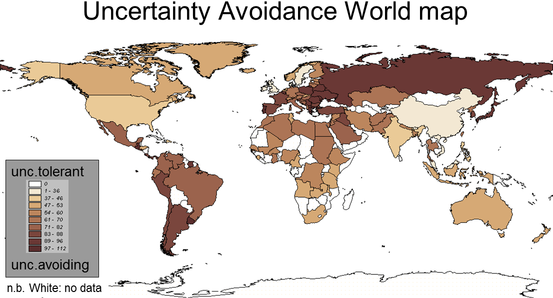
Application: In Hofstede’s model, Greece 🇬🇷 tops the UAI scale with 100, while Singapore 🇸🇬 scores the lowest with eight.
Therefore, during a meeting in Greece 🇬🇷, you might be keen to generate discussion, because you recognize that there’s a cultural tendency for team members to make the safest, most conservative decisions, despite any emotional outbursts. Your aim is to encourage them to become more open to different ideas and approaches, but it may be helpful to provide a relatively limited, structured set of options or solutions.
| UAI | Characteristics | Tips for this characteristic |
|---|---|---|
| High UAI | ⚪ Conservative, rigid and structured, unless the danger of failure requires a more flexible attitude. ⚪ Many societal conventions. ⚪ People are expressive, and are allowed to show anger or emotions, if necessary. ⚪ A high energy society, if people feel that they are in control of their life instead of feeling overwhelmed by life’s vagaries. |
» Be clear and concise about expectations and goals, and set clearly defined parameters. But encourage creative thinking and dialogue where you can. » Recognize that there may be unspoken “rules” or cultural expectations you need to learn. » Recognize that emotion, anger and vigorous hand gestures may simply be part of the conversation. |
| Low UAI | ⚪ Openness to change or innovation, and generally inclusive. ⚪ More inclined to open-ended learning or decision making. ⚪ Less sense of urgency. |
» Ensure that people remain focused, but don’t create too much structure. » Titles are less important, so avoid “showing off” your knowledge or experience. Respect is given to those who can cope under all circumstances. |

Long- Versus Short-Term Orientation 🔗
This dimension was originally described as “Pragmatic Versus Normative (PRA).” It refers to the time horizon people in a society display. Countries with a long-term orientation tend to be pragmatic, modest, and more thrifty. In short-term oriented countries, people tend to place more emphasis on principles, consistency and truth, and are typically religious and nationalistic.
In countries with high LTO scores, people are inclined to act pragmatically in the present in order to prepare for the future. They are acutely aware of how events in the past, even those that predate their own birth, contributed to current circumstances and are therefore likely to display humbleness and frugality in times of plenty, and flexibility and resourcefulness in hard times. Long-term oriented cultures prize education, thrift, and good planning and are willing to delay gratification in the name of a more secure tomorrow.
In more short-term oriented countries, people generally view the horizon of impactful events in a limited way. They do not necessarily perceive a connection between events of the past and the circumstances of the present, and may be especially reluctant to see events that predated their birth as having any influence on their lives. People from countries with low LTO scores may be inclined to lavishness in times of plenty, and may cite “acts of God” when faced with crises. Short-term oriented cultures prize instant results and immediate gratification and are averse to making sacrifices in the here-and-now for the promise of a future payoff.
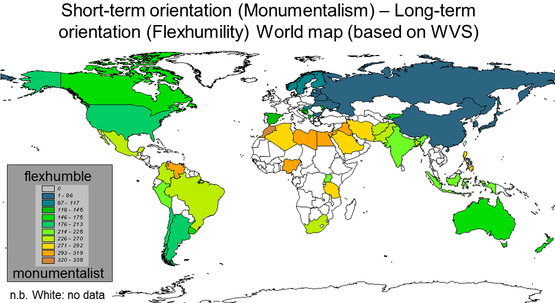
Application: The U.S. 🇺🇸 has a short-term orientation. This is reflected in the importance of short-term gains and quick results (profit and loss statements are quarterly, for example). It is also reflected in the country’s strong sense of nationalism and social standards.
| PRA | Characteristics | Tips for this characteristic |
|---|---|---|
| Long-Term Orientation | ⚪ People often wonder how to know what is true. For example, questions like “What?” and “How?” are asked more than “Why?” ⚪ Thrift and education are seen as positive values. ⚪ Modesty. ⚪ Virtues and obligations are emphasized. |
» Behave in a modest way. » Avoid talking too much about yourself. » People are more willing to compromise, yet this may not always be clear to outsiders; this is certainly so in a culture that also scores high on PDI. |
| Short-Term Orientation | ⚪ People often want to know “Why?” ⚪ Strong convictions. ⚪ As people tend to oversell themselves, others will assess their assertions critically. ⚪ Values and rights are emphasized. |
» Sell yourself to be taken seriously. » People are less willing to compromise as this would be seen as weakness. » Flattery empowers. |

Indulgence Versus Restraint (IVR) 🔗
Hofstede’s sixth dimension, discovered and described together with Michael Minkov, is also relatively new, and is therefore accompanied by less data.
Countries with a high IVR score allow or encourage relatively free gratification of people’s own drives and emotions, such as enjoying life and having fun. Those in which social structures are built to acknowledge human desires and encourage people to pursue their fulfillment. People from indulgent countries are likely to place value on freedom of speech, to emote freely, and to actively solicit feedback from those around them. Within high IVR countries, people may be inclined to see leisure as a virtue and pleasure as theirs for the taking. They may tend to think less of those they perceive to be humorless, unhappy, or generally dissatisfied with the state of their lives.
In a society with a low IVR score, there is more emphasis on suppressing gratification and more regulation of people’s conduct and behavior, and there are stricter social norms. Social structures are generally built in a way that suppresses emotion and desires and equates duty with destiny. Restrained cultures are those that regulate behavior via strict social norms and prioritize the fulfillment of one’s obligations as the fulfillment of one’s life purpose. People from countries with low IVR scores may be reluctant to offer their opinion and may feel guilt or shame for engaging in frivolous activities. They may regard those who emote freely or openly indulge in such pleasures as foolish, wanton, or unprofessional.
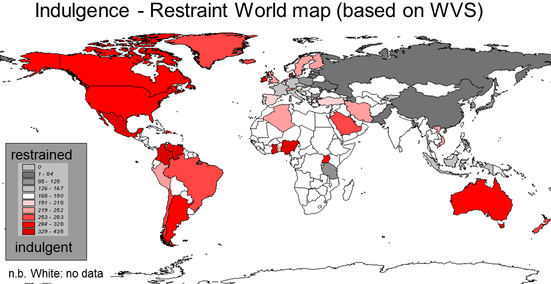
Application: According to the model, Eastern European countries, including Russia 🇷🇺, have a low IVR score. Hofstede argues that these countries are characterized by a restrained culture, where there is a tendency towards pessimism. People put little emphasis on leisure time and, as the title suggests, people try to restrain themselves to a high degree.
| PDI | Characteristics | Tips for this characteristic |
|---|---|---|
| High Indulgence | ⚪ Optimistic. ⚪ Importance of freedom of speech. |
|
| Focus on personal happiness. | » Don’t take life too seriously. » Encourage debate and dialogue in meetings or decision making. » Prioritize feedback, coaching and mentoring. » Emphasize flexible working and work-life balance. |
|
| High Restraint | ⚪ Pessimistic. ⚪ More controlled and rigid behavior. |
» Avoid making jokes when engaged in formal sessions. Instead, be professional. » Only express negativity about the world during informal meetings. |
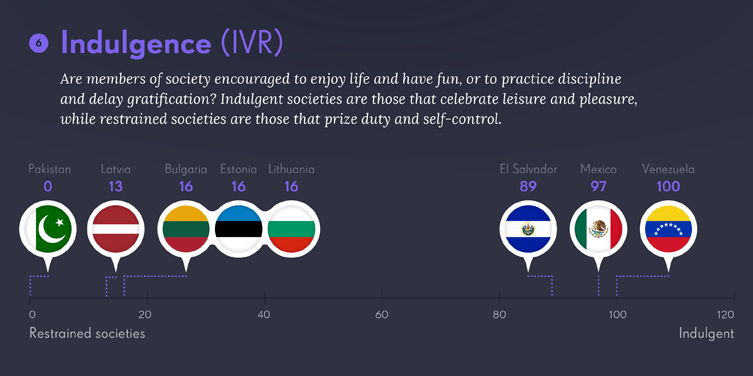
Key Points 🔗
Cultural norms play a large part in interpersonal relationships at work. When you grow up in a certain culture, you take the behavioral norms of your society for granted. You don’t have to think about your reactions, preferences and feelings, provided that you don’t deviate too much from your society’s central tendency.
However, when you step into a foreign culture, things suddenly seem different, and you don’t want to cause offense. By using Hofstede’s Cultural Dimensions as a starting point, you can evaluate your approach, your decisions, and your actions – based on a general sense of how people in a particular society might think and react.
Of course, everybody is unique, and no society is uniform. But you can use the Hofstede model to make the unknown less intimidating, to help you to avoid making mistakes, and to provide a much-needed confidence boost when you’re working in an unfamiliar country.
video (15:20 minutes) 🔗
Geert Hofstede : Importance of an international perspective (2015)
References 🔗
- https://www.mindtools.com/pages/article/newLDR_66.htm
- https://expertprogrammanagement.com/2012/05/hofestedes-cultural-dimensions/
- https://www.reservations.com/blog/resources/power-distance-index/
- https://hi.hofstede-insights.com/the-culture-compass
- https://exhibition.geerthofstede.com/hofstedes-globe/
- https://www.geerthofstede.com
- Geert Hofstede, Gert Jan Hofstede, Michael Minkov, “Cultures and Organizations, Software of the Mind”, Third Revised Edition, McGraw-Hill 2010, ISBN 0-07-166418-1.

